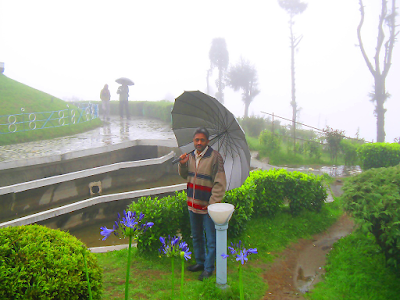Umbrella
The umbrella is your inevitable appendix if you live in Kerala. It used
to hang on my shoulder as I trekked to school in my childhood. There were no folding
umbrellas or pocket umbrellas in those days. My umbrella like most people’s was
a half-metre long canopy with a ferrule that jutted out so that you could use
the whole thing as a walking stick when it did not rain. The men’s umbrella had
a curved handle which enabled you to suspend it on your shoulder if you didn’t
want the walking stick. The rains lashed Kerala for nearly half the year in
those days and hence the umbrella was a loyal friend and as cumbersome too.
The fidelity of the umbrella continued when I left the state to take up
my first job in Shillong as a teacher. Shillong too had quite a lot of rains in
those days with its proximity to Cherrapunji. Eventually, however, the rains in
Shillong became as flighty and coquettish as the place itself and Cherrapunji
lost its designation as the place of heaviest rainfall to Mawsynram.
Shillong gave me the Umbrella Man who became a perennial presence in my
life there.
I read the short story, ‘Umbrella Man,’ in one of the lessons of the
creative writing course of IGNOU. The protagonist of that story is hit by an
umbrella on the back of his head as he sits in a bus. He thinks it happened by
mistake. But the hit is repeated. He warns the fellow on the back seat, who is
the Umbrella Man, not to do that but to no avail. Finally he gets up and gives
a punch on the Umbrella Man’s nose which starts bleeding. But the knocks
continue at regular intervals. Finally the protagonist alights near the police
station in order to file a complaint. The Umbrella Man walks close behind him
awarding the knocks on his head religiously. When they are about to enter the
police station, the protagonist thinks that he might become the culprit since
it is the other fellow’s nose that is bleeding. Hence he chooses to be worldly wise
and retraces his steps. The Umbrella Man follows him home and enters inside
even before the door could be shut. The knocks on the head continue wherever
the protagonist goes, whatever he may be doing. Days give way to weeks and
months. Eventually the protagonist gets used to the Umbrella Man’s knocks. He
falls in love with them. He cannot now live without them.
A few years after I read that story, I got an Umbrella Man in Shillong.
A Catholic priest incarnated as the Umbrella Man in my life though he was as
invisible as his God and as irascible too. The frequency and intensity of his
knocks depended on how he judged my actions. The Christian God is a terrible
jurist, if you know Him, and I must confess that I gave Him ample occasions to
wield his canonical umbrella on my sinful head.
Unlike the protagonist in the story, I got tired of the knocks after a
few years. That’s when I quit and landed in Delhi where umbrellas had little
role. Delhi is a desert as far as the scientific measures of rainfall are
concerned. However, I did buy an umbrella. Nostalgia is as soothing as the
scratch you give to the healing wound.
The umbrella I bought years ago from Delhi continues to be my companion
even now when I’m in Kerala once again completing the circle of my travels and
travails. The umbrella lies in the little box near the gear shaft in my car
ready for any eventuality during a journey. Though it is seldom used, its very
sight fills me with a gratification that Freud would associate with my dark
unconscious demons.
The umbrella makes me happy. Strangely.


True, Kerala and the Umbrella just cannot be separated from each other. The innovative ideas the umbrella-makers in the state come up with every year, is amazing. And those umbrellas designed for the southwest monsoon are also known for their quality, aren't they?
ReplyDeleteNice to learn about the Umbrella man. Interesting story.
The innovative approach of the umbrella manufacturers i Kerala is indeed amazing.
DeleteThe Umbrella Man is a story that's open to multiple interpretations.
In mumbai the umbrella is a constant companion to me and many mumbaikars. In rains it used to keep oneself dry and in other seasons a shield against the abundant Sun.
DeleteThe umbrella has its prgamatic sides too 😏
DeleteWell, there are the beautiful ones too, that see the light of the day only in summers unlike the big umbrellas that take the trouble with the rains.
ReplyDeleteIndeed, umbrellas are works of art now, exquisite ones too.
DeleteIn Delhi you could have used your umbrella to get protection from sun. Nice post. Enjoyed reading.
ReplyDeleteI was staying on the campus and so there was no need of an umbrella even on a rainy day.
DeleteGlad you liked this.
Nice narration of perpetual friend..-:)
ReplyDeletePerpetual friend. Precisely. 😏
DeleteThe story of Umbrella man is interesting, its an wonderful read on Umbrella. Sometime such umbrella men visit our lives and except avoiding you have no other way left.
ReplyDeleteWe all live under that umbrella, alas. The umbrella may be called BJP or whatever .
DeleteUmbrella, actually covers an umbrella of meaning
ReplyDeleteWow!You got it!
DeleteYou are proving very good and relevant information.
ReplyDeletePromotional Umbrellas UK
Promotional Merchandise UK